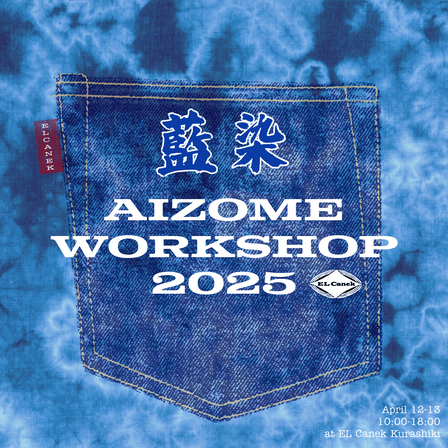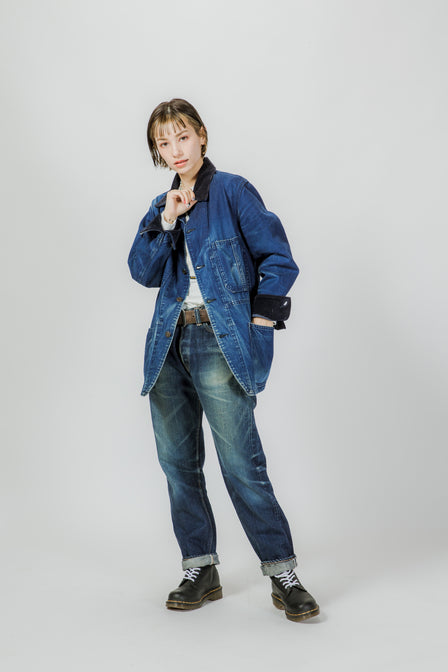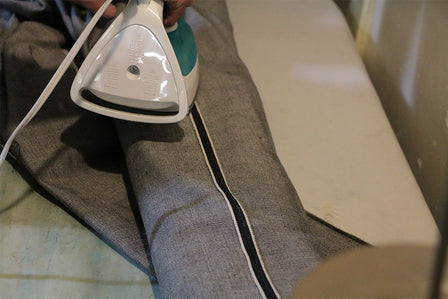Discover the Timeless Art of Japanese Indigo Dyeing
Aizome Workshop 2025 | April 12 & 13 at EL Canek Kurashiki
Step into the rich world of Japanese indigo dyeing, or Aizome—a centuries-old tradition that originated from China and flourished during Japan’s Edo period as the “color of the people.” Known for its deep blue hue and natural antibacterial properties, indigo dyeing was historically used to prevent skin conditions and protect against poisonous insects.
At our upcoming Aizome Workshop, you’ll get a behind-the-scenes look at how we craft our SH-01 linen shirt in collaboration with TKD Works, a linen fabric maker from Shizuoka. Designed by EL Canek founder Masayuki Kanatani, the shirt features unique elements such as an asymmetrical front button closure and hidden buttonholes on the sleeves. Each piece is carefully hand-dyed by skilled artisans, making every shirt one-of-a-kind.
The Indigo Dyeing Process
Indigo dyeing uses the power of nature. The indigo plant leaves, when exposed to air or water, transform into a vibrant blue dye called indigo. The process of dyeing allows for creative expression—the more times you dye the fabric, the deeper the color, and the more variation in pattern you can achieve.
For fresh leaf dyeing, known as 生葉染め (Namaha-zome), the leaves are blended with 10–20 times their volume in water, then strained to create a dye bath. Fabrics are gently soaked and aerated to trigger oxidation—the magical moment when the dye turns from green to deep blue. It’s essential to oxidize the fabric after dyeing, as indigo turns blue only when it reacts with air.
We’ll also explore the traditional fermentation-based method called “Hondate” or “Hell Date” (本建て/地獄建て), where indigo is reduced into a water-soluble state using fermented Sukumo (composted indigo leaves). This ancient process uses enzymes and time to unlock the full power of indigo—a truly time-honored technique passed down through generations.
Join Us for the Experience
On April 12 (Sat) & 13 (Sun), we’ll be hosting a special indigo dyeing event at our EL Canek Kurashiki store.
We’re honored to welcome natural dye artist Ms. Asayama, who will lead the workshop using both fresh-leaf and traditional fermentation techniques.
We’ll provide items like T-shirts, handkerchiefs, and stoles to dye, but you’re also welcome to bring your own pieces (shirts, sneakers, scarves, etc.) to transform with your personal touch.
Come feel the joy of hand-dyeing and immerse yourself in a piece of Japanese culture 🫶
Reserve Your Spot Now
🔗https://elcanekjeanslab.com/products/linen-sh-01?variant=40083523633223
📩Or DM us on instagram @elcanekjeanslab
藍の生葉染めの方法
伝統的な染色技術として日本でも古くから親しまれてきた藍染。
古来、中国から伝わり、江戸時代には庶民の色として親しまれました。殺菌作用が強く、染めた衣服で皮膚病や毒虫を防ぎました。
藍の持つ成分は、空気や水に触れることでインディゴ(青く染まる成分)に変化します
染める回数によって色の濃さを変えたり、模様をつけたり。工夫次第でオリジナリティを出すこともできます。
藍の生葉(葉のみ)に10〜20倍の水を加えてミキサーにかける。葉が多ければ、何回かに分けて繰り返す。ゴム手袋をして、漉し布で葉を漉し、染液をつくる。
染液に布を浸して、布全体に染み渡るように布をくゆらす。15分間浸す間に布を広げ、空中でなびかせ酸化させる。
※ 藍の成分は空気に触れると酸化して青く発色します。発色した後では生地に色がつかないので、発色する前に、生地に染液を染み込ませるようにして下さい。
エルカネックリネンシャツ-藍染。TKD Works様とコラボさせていただいた人気商品。追加料金で職人の手により藍染もさせていただきます。リネン100%で通気性も手触りも良く、初夏のこの季節におすすめの商品です。🍃真夏が始まる今の時期に大活躍間違い無し。ぜひ一枚いかがですか?お店にお立寄りの際はお気軽にご試着くださいませ。
NEWS
4月12日(土)、13日(日)の2日間、EL Canek倉敷店にて草木染め作家の浅山様にお越しいただき藍染めのワークショップを行います。Tシャツ、ハンカチ、ストールをご用意しておりますのでお気軽に遊びにいらしてください!何か染めたい物(シャツ、ハンカチ等)などがあれば持ち込んでいただいても大丈夫です。是非手染めの楽しさを体感してください🫶
了解更多
日本工作文化和工艺介绍:日本牛仔裤品牌的视角——反映对@sprouht 的采访。
图片来自Sprouht-YouTube频道

今年早些时候,我们的创始人 Kanatani Masayuki 有幸接受了内容创作者和企业家 Will Rossy 先生(sprouht)的采访。采访发布在他的 YouTube 频道上( 点击此处观看)。今天,我们想让您更深入地了解我们独特的工作文化以及日本社会工艺的演变。
众所周知,过度劳累及其负面影响在社会中普遍存在。我们充分了解这一问题的重要性,并致力于在需要关注的领域做出改进。日本的工作改革运动势头强劲,尤其是在年轻一代中,我们对未来的改进充满信心。
在我们的牛仔品牌中,创始人 Kanatani 用 30 多年的时间追求自己的激情。通过他坚定不移的承诺,日本工艺已超越了单纯的劳动,发展成为一种代表着极致奉献和技艺的精致艺术形式。我们将激情投入到精心打造的手工牛仔单品中,这些单品体现了我们品牌的精髓。
日本的工作文化和传统工艺都具有奉献、注重细节和协作的价值观。传统工艺强调等级制度,而日本的工作文化则重视团队合作和实现共同目标。这些价值观帮助日本成为工艺和创新领域的全球领导者。
总之,我们认识到社会上存在过度劳累和工作时间过长的问题,并积极参与工作改革工作。我们对所取得的进步感到鼓舞,尤其是年轻一代,并热切期待在不久的将来取得进一步的进步。在我们的牛仔品牌中,Kanatani 总裁三十年来对他的热情的坚定奉献体现了日本工艺作为一种真正艺术形式的变革力量。通过我们的手工作品,我们不仅表达了我们的热情,还为保护和弘扬这一受人尊敬的传统做出了贡献。





